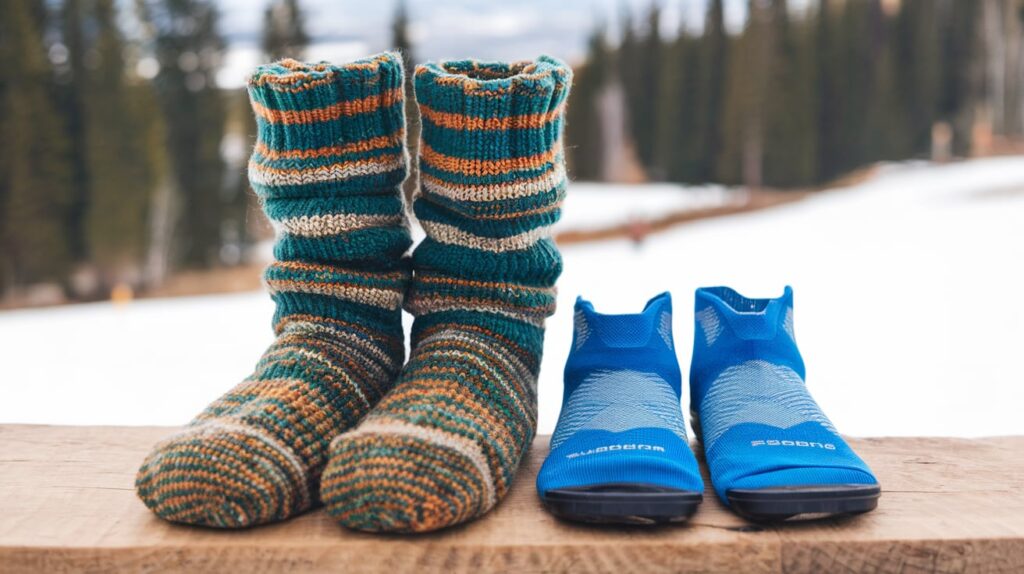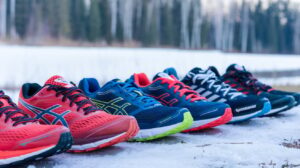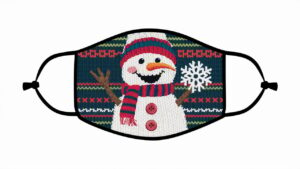When you’re gearing up for a ski trip, every detail matters. One question often overlooked is whether to choose thick or thin socks for skiing.
You might be tempted to grab the thickest pair you own, assuming more padding equals more warmth. But is that really the best choice for your feet on the slopes? This dilemma isn’t just about comfort; it impacts your skiing experience and performance.
Will your choice keep you cozy or leave your feet crying out for relief? Imagine gliding down the mountain with confidence, knowing your feet are perfectly snug and supported. The right socks can make or break this experience. Your decision could enhance your skiing adventure or lead to discomfort that distracts from the thrill. We’re here to help you navigate this choice, so you can focus on what really matters—enjoying every exhilarating moment on the snow. Stay tuned to discover the ultimate sock strategy for your next ski trip.
Importance Of Choosing The Right Ski Socks
Skiing demands the right gear for comfort and performance. Ski socks play a vital role in this. Choosing the right socks can make or break your skiing experience. They keep your feet warm, dry, and comfortable on the slopes. The wrong socks lead to discomfort, cold feet, or even blisters. Whether thick or thin, the right socks enhance your skiing adventure.
Why Thickness Matters
The thickness of ski socks impacts warmth and cushioning. Thick socks provide extra warmth in extremely cold conditions. They offer added padding which helps absorb shock. Thin socks are better for tighter boots. They allow more precise control and a snug fit. Choose the thickness based on weather and boot fit.
The material of ski socks affects comfort and performance. Wool is a popular choice for its warmth and moisture-wicking properties. Synthetic materials offer durability and breathability. Blended fabrics provide a balance of comfort and function. Consider your skin’s sensitivity when choosing sock material.
Fit And Comfort
The fit of ski socks is crucial for comfort. Socks should hug the foot without being too tight. A proper fit prevents bunching and discomfort. Check that the socks offer arch support and cushioning. Comfortable socks enhance your skiing experience significantly.
Temperature Regulation
Temperature regulation is essential for skiing comfort. Socks should keep feet warm without overheating. Breathable materials help manage moisture and temperature. Choose socks that suit the day’s weather conditions. Keeping feet dry and warm ensures a pleasant ski day.
Preventing Blisters
Blisters can ruin a skiing trip. The right socks reduce friction and prevent blisters. Look for socks with reinforced areas on heels and toes. Proper fit and quality materials contribute to blister prevention. Protect your feet by choosing socks wisely.
Factors Affecting Sock Choice
Choosing between thick and thin socks for skiing depends on warmth, comfort, and boot fit. Thick socks offer extra warmth but may feel snug in tight boots. Thin socks provide better boot fit and breathability, ideal for warmer conditions or snug boots.
Factors affecting your choice of skiing socks can make or break your experience. Choosing the right socks isn’t just about style. It’s about ensuring comfort, warmth, and performance on the slopes. Several key factors influence this crucial decision.
Weather Conditions
Weather plays a vital role in sock selection. Cold weather demands thicker socks. They provide warmth and insulation. In milder temperatures, thinner socks keep feet from overheating. Check the forecast before packing. Choose your socks based on the day’s conditions.
Ski Boot Fit
Boot fit is another important factor. Tight boots need thinner socks for comfort. Thick socks can cause pressure and pain. Loose boots may benefit from thicker socks. They fill space and improve fit. Always try socks with your boots before skiing.
Personal Comfort Preferences
Everyone has different comfort needs. Some prefer the cushion of thick socks. Others like the lightness of thin ones. Consider your personal comfort first. Test both types before deciding. Comfort can enhance your skiing enjoyment. Choosing the right socks enhances your skiing experience. Consider these factors for a perfect ski day.
Benefits Of Thick Ski Socks
Thick ski socks offer superior warmth and cushioning. They protect feet from cold and reduce boot pressure. Skiers enjoy enhanced comfort and fewer blisters on the slopes.
When you’re gearing up for a skiing adventure, choosing the right socks might not be at the top of your checklist. However, the benefits of thick ski socks are not to be underestimated. They can make a substantial difference in your comfort and performance on the slopes.
Enhanced Warmth
Thick ski socks are your best friend in keeping your feet warm. When you’re skiing, the last thing you want is cold feet. Thicker materials provide better insulation, trapping heat and preventing the chill from seeping in. Imagine gliding down the slope with feet that feel like they’re wrapped in a warm hug. Isn’t that a comforting thought? Thick socks can transform a potentially uncomfortable experience into a cozy one.
Cushioning For Comfort
Comfort is key when you’re spending hours in ski boots. Thick socks offer additional padding that acts as a cushion for your feet. This extra layer helps absorb shock and reduce pressure points, allowing you to ski longer without discomfort. Consider the difference that a soft, padded surface makes when you walk or run. The same principle applies when skiing. Thick socks can help prevent blisters and soreness, so you can focus on enjoying the slopes.
Ideal For Loose-fitting Boots
Have you ever worn boots that felt just a tad too loose? Thick ski socks can provide a snugger fit. They fill in the gaps, ensuring your feet are secure, and reducing the risk of foot movement that can cause friction and blisters. This can be particularly beneficial if you’re renting ski boots. Rental boots often come in standard sizes that might not fit perfectly. Thick socks can be your secret weapon to achieving a better fit, offering stability and control as you navigate the slopes. As you prepare for your next skiing adventure, consider the benefits of thick ski socks. They might just be the game-changer your skiing experience needs. So, are you ready to elevate your comfort and warmth on the slopes?
Advantages Of Thin Ski Socks
Choosing the right socks for skiing can improve your experience. Thin ski socks offer several benefits. They enhance your comfort on the slopes. Discover the advantages of wearing thin ski socks.
Better Boot Fit
Thin socks provide a snug fit in ski boots. This means less bulk inside the boot. It allows for a more precise fit. Skiers often find better balance this way. A good boot fit can reduce foot fatigue. This leads to longer, more enjoyable skiing.
Increased Sensitivity And Control
Thin socks increase your sensitivity to movements. You can feel the terrain better. This helps in making quick adjustments. Skiers gain more control over their skis. Precision in movement becomes easier. Improved control can boost your confidence on the slopes.
Quick Drying Properties
Thin ski socks dry faster than thick ones. This is important for warmth. Wet socks can make feet cold. Quick drying keeps your feet comfortable. Less moisture means less risk of blisters. Enjoy a more pleasant skiing day with dry feet.
Material Considerations
Choosing the right socks for skiing is crucial. Material plays a key role. It impacts comfort and performance on the slopes. The two main options are wool and synthetic fibers. Each has unique benefits and drawbacks. Understanding these can help make an informed choice.
Wool Vs. Synthetic Fibers
Wool offers natural warmth. It insulates even when wet. Merino wool is soft and not itchy. It regulates temperature well, keeping feet comfortable. Synthetic fibers like polyester provide durability. They dry faster than wool. They often cost less. Both materials have their place in skiing socks.
Moisture-wicking Abilities
Keeping feet dry is vital for comfort. Wool naturally wicks moisture away. It keeps feet dry and warm. Many synthetic fibers are designed to wick moisture too. They do this by moving sweat to the sock’s outer layer. This helps keep feet dry even in intense activity.
Durability And Longevity
Durability matters in skiing socks. Wool is strong but can wear out. Synthetic fibers often last longer. They resist wear and tear better. Choosing a durable sock means it will last through many ski trips. Investing in quality materials pays off over time.

Common Ski Sock Myths
Choosing the right socks for skiing can be confusing. Many myths surround ski socks, leading to poor choices. Understanding these myths can enhance your skiing experience. Knowing the truth helps you enjoy the slopes comfortably.
Thicker Means Warmer
Many believe thick socks are warmer. This isn’t always true. Thick socks can cause sweating. Wet feet lose heat faster. Thin, wool-blend socks wick moisture away. They keep your feet dry and warm. It’s about material, not thickness.
Socks Should Be Worn Over Pants
Some ski myths say socks go over pants. This can lead to discomfort. Socks should fit snugly against the skin. Wearing them over pants adds bulk. It can affect your boot fit. Keep socks inside your pants. Ensure comfort and better performance.
Tips For Choosing Your Ideal Pair
Choosing the right socks for skiing is crucial. Thick socks offer warmth, perfect for cold conditions. Thin socks provide a snug fit, enhancing boot comfort. Consider weather and personal comfort to select the ideal pair for your skiing adventure.
Choosing the right socks for skiing can make a world of difference in your comfort and performance on the slopes. Whether you prefer thick or thin socks depends on various factors, and finding your ideal pair requires a bit of experimentation and understanding. Let’s dive into some practical tips to help you choose the perfect pair of socks for your next skiing adventure.
Assessing Your Skiing Style
Your skiing style plays a crucial role in sock selection. Are you an aggressive skier who loves challenging terrains, or do you prefer a more laid-back approach on gentle slopes? Thicker socks offer more cushioning, which can be beneficial for high-impact skiing. However, if you enjoy precision and a close fit with your boots, thinner socks might be more suitable.
Trying Different Brands And Fits
Not all socks are created equal. Different brands offer varying materials and designs, which can affect how they feel and perform. Visit a ski shop and try on a few different brands. Notice how each pair feels in your boots and pay attention to any pressure points or areas of discomfort.
Considering Layering Options
Layering isn’t just for clothing. Some skiers find that wearing a thin liner sock under a thicker ski sock provides the perfect combination of warmth and comfort. Experiment with this layering technique to see if it offers an improved fit and additional warmth for you. Just ensure that the extra layer doesn’t make your boots too tight, as this can restrict circulation and lead to cold feet. Remember, the perfect sock for skiing doesn’t just magically appear. It takes some thought, a bit of trial and error, and a willingness to experiment. Have you ever tried different sock combinations to find your perfect pair? What worked best for you? Share your experiences and help others find their ideal ski socks!
Maintaining And Caring For Ski Socks
Choosing the right ski socks is crucial for comfort on the slopes. Thick socks offer warmth, ideal for cold conditions. Thin socks provide better fit in tight boots, enhancing control and movement. Proper care ensures durability, keeping them fresh and effective throughout the ski season.
Caring for your ski socks is crucial if you want them to provide the best performance and comfort during your ski adventures. Proper maintenance ensures that your socks last longer and continue to offer the warmth and support you need on the slopes. Let’s dive into how you can keep your ski socks in top condition.
Proper Washing Techniques
Washing your ski socks correctly is the first step in maintaining their quality. Always check the care label for specific instructions, but generally, wash them in cold or lukewarm water. Use a mild detergent to avoid damaging the fibers and skip the fabric softeners—they can reduce the socks’ moisture-wicking abilities. Turn your socks inside out before washing. This helps protect the outer surface and ensures a thorough clean, especially if there’s a lot of sweat buildup. If you’re using a washing machine, opt for a gentle cycle to prevent unnecessary wear and tear.
Storage Tips For Longevity
Storing your ski socks properly can significantly extend their lifespan. Make sure they are completely dry before putting them away to prevent any mold or mildew. Roll them instead of folding to maintain their elasticity and shape. Consider keeping them in a dedicated drawer or storage box. This prevents them from getting tangled with other clothing items and reduces the risk of snagging. Keeping them in a cool, dry place also helps maintain the fabric integrity.
When To Replace Your Socks
Knowing when to replace your ski socks is essential for comfort and performance. Look out for signs like thinning fabric, persistent odors, or loss of elasticity. If your socks no longer provide the warmth they used to, it’s time to get a new pair. You might also notice that even after washing, they don’t feel as snug or supportive. This is a clear indication that their functional life is over. Consider keeping a couple of spare pairs in your ski bag. This way, you can swap them out when needed and never have to worry about discomfort on your ski trips. How do you care for your ski socks? Do you have a unique method that keeps them fresh and functional? Share your tips and tricks in the comments below!
Frequently Asked Questions
What Type Of Socks Is Best For Skiing?
When skiing, choose socks that offer warmth, comfort, and moisture-wicking. Thick socks provide extra insulation, while thin socks offer better control and fit. The best choice depends on personal preference and skiing conditions. Thin socks are often preferred for better boot fit and control during skiing.
Are Thick Socks Necessary For Skiing?
Thick socks are not always necessary for skiing. They provide warmth but can reduce boot control. Many skiers prefer thin socks for better fit and control in ski boots. The choice depends on personal comfort, skiing conditions, and individual preference.
Ensure your socks are moisture-wicking for optimal performance.
Do Thin Socks Improve Skiing Performance?
Thin socks can improve skiing performance by enhancing boot fit and control. They allow better foot movement, offering a more precise ski experience. While thick socks provide warmth, thin socks are often preferred for better control. Choose socks that are moisture-wicking to keep feet dry and comfortable.
Can I Wear Regular Socks For Skiing?
Regular socks are not recommended for skiing. They lack moisture-wicking and warmth features needed for ski conditions. Ski-specific socks provide better insulation, fit, and moisture control. Opt for socks designed for skiing to ensure comfort and performance on the slopes.
Proper ski socks enhance your skiing experience.
Conclusion
Choosing the right socks is vital for skiing comfort. Thick socks offer warmth and cushioning. Thin socks provide better control and fit. Consider the weather and your personal comfort. Cold days might need thicker socks. Warmer days could suit thin ones.
Always prioritize your own comfort. Try different options to find the best match. Socks play a crucial role in your skiing experience. Happy skiing!








